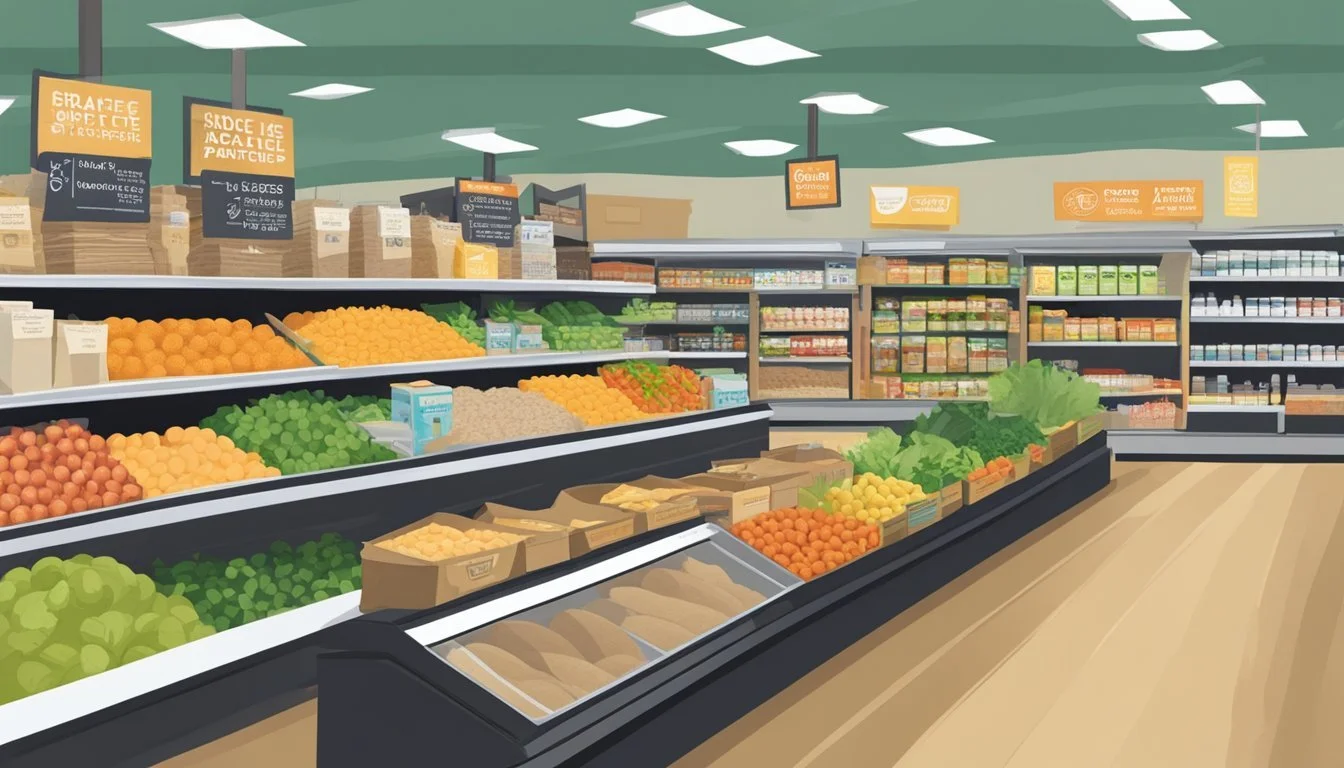Budget-Friendly Grain-Free Shopping
Essential Tips for Cost-Saving Diets
Adopting a grain-free diet can be a strategic choice for those seeking health benefits such as reduced inflammation or to comply with certain dietary restrictions. However, many shoppers hesitate at the prospect, fearing that grain-free alternatives will inflate their grocery bill. Fortunately, with careful planning and strategic shopping, maintaining a healthy, grain-free diet doesn't have to break the bank.
Approaching the grocery store armed with a well-thought-out plan is essential. Meal planning allows shoppers to buy only what they need, reducing waste and cost. By focusing on seasonal produce and sales, consumers can incorporate a variety of nutrients into their diet without relying on grains. In addition, purchasing budget-friendly and versatile staples such as bulk nuts (What wine goes well with nuts?), seeds, and eggs can lay the foundation for numerous grain-free meals.
Shopping for a grain-free diet also requires a shift in shopping habits. Instead of heading straight for processed foods, budget-conscious consumers can save money by choosing whole, unprocessed foods like fresh vegetables and proteins, which offer better nutritional value. By prioritizing the perimeter of the store where fresh items are typically located, shoppers can avoid the higher costs and lower nutritional content commonly associated with packaged and processed grain-free products.
When it comes to maintaining a grain-free lifestyle, shopping on a budget is not only possible but also exciting! With a little creativity and savvy planning, you can enjoy a wallet-friendly grain-free shopping experience that supports your health and well-being.
Start by exploring the wide range of grain-free food brands and products available in the market. Many of these options offer affordable and delicious alternatives that cater to various dietary needs, ensuring that you can enjoy a diverse and satisfying grain-free diet without breaking the bank.
Thanks to the latest grain-free science research, we now understand the benefits of reducing grains in our diet, particularly for individuals with grain-free digestive disorders. By prioritizing grain-free options in your shopping, you can support your digestive health while being mindful of your budget.
Building a grain-free kitchen pantry doesn't have to be expensive. Stock up on cost-effective grain-free flour alternative like almond flour, coconut flour, and tapioca flour to create a wide variety of grain-free recipes without overspending.
And for pet owners, there are also affordable grain-free pet food options available to ensure that your furry friends can enjoy the benefits of a grain-free diet too.
Exploring grain-free international cuisine can also provide budget-friendly inspiration for your shopping list. From affordable Mexican-inspired dishes to budget-friendly Mediterranean flavors, there are plenty of delicious and grain-free options to explore without breaking the bank.
With these tips and tricks, you can embrace a grain-free lifestyle while keeping your budget in check, making it easier and more enjoyable than ever to prioritize your health and well-being.
Understanding the Grain-Free Lifestyle
Adopting a grain-free lifestyle often entails dietary modifications aimed at improving health. This approach involves the exclusion of all grain products from one's diet.
Benefits of Grain-Free Diets
A grain-free diet eliminates all grains, including wheat products containing gluten, as well as gluten-free grains like rice, corn, oats, and barley. Individuals often adopt this diet for a variety of health reasons. One benefit of a grain-free lifestyle is the potential for improved digestive health, as some people experience less bloating and inflammation when they avoid grains. Additionally, it can be part of managing celiac disease or gluten sensitivity.
Gluten-Free: Although "gluten-free" and "grain-free" are not synonymous, a grain-free diet is inherently gluten-free as well, catering to those with gluten intolerances.
Healthy Eating: A focus on whole foods allows for a more nutrient-dense diet, often rich in vegetables, fruits, proteins, and healthy fats.
Challenges of Staying on Budget
The main challenge individuals face when adopting a grain-free lifestyle is maintaining an affordable meal plan. Grain-free diets can be costly due to the higher price of alternative flours and products.
Cost: Grain-free products and alternative flours often come at a premium, which can add up quickly.
Meal Planning: Requires careful planning to ensure meals remain budget-friendly and healthy.
Tips for Affordability:
Buying in bulk can save money.
Focusing on less expensive proteins, such as eggs and chicken, helps keep costs down.
Intermittent fasting can be considered a way to reduce meal frequency and therefore the cost associated with those meals.
Strategic Shopping Practices
When adopting a grain-free lifestyle, shoppers can maintain their budget by mastering the art of strategic shopping. A well-thought-out grocery list and an awareness of common pricing pitfalls pave the way for savvy spending.
Creating a Master Grocery List
A master grocery list is the cornerstone of strategic shopping, particularly for grain-free buyers. This list should be based directly on a well-crafted meal plan for the week or month ahead. Shoppers can take advantage of sales and bulk purchasing opportunities, but only for items that will be utilized before their expiration. This minimizes waste and ensures that the budget is utilized efficiently. An effective list typically includes:
Fresh produce for planned meals
Protein sources that fit the grain-free criterion
Grain-free pantry staples, such as nuts and seeds, to buy in bulk if on sale
Recognizing Price Traps at the Store
Shoppers must navigate the grocery store with a discerning eye, as not all deals are beneficial in the long term. Sales can be tempting, but they often lead to buying items that are not on the shopping list or that are unnecessary for one's meal plan. To avoid overspending:
Stick to the master grocery list despite in-store promotions
Compare unit prices to ensure bulk deals are truly cost-effective
Beware of endcap and checkout displays designed to encourage impulse purchases
Budgeting for Grain-Free Diets
Adopting a grain-free diet often requires meticulous financial planning to remain cost-effective. The goal is to allocate funds in a manner that reduces monthly expenses without sacrificing nutrition. It’s paramount to balance the budget with the nutritional richness of grain-free foods.
Allocating Funds Wisely
One begins by creating a monthly budget that prioritizes grain-free staples such as meats, fish, eggs, and a variety of protein-rich plant foods. They should include legumes, tofu, and soy products like soymilk and soy yogurt. It’s beneficial to invest in bulk buying and seasonal produce to save money.
Expenses are then categorized and resources are allocated for:
Proteins: Meats, seafood, eggs, dairy resources, and plant-based proteins.
Vegetables: A broad spectrum of fresh, frozen, or canned options.
Fruits: Primarily berries and other low-glycemic varieties.
Fats: Nuts, seeds, and healthy oils like olive and coconut oil.
Tracking Spending and Savings
Using tracking tools such as apps or spreadsheets, one can monitor where money is being spent and identify areas for cost reduction. Special attention to weekly flyers, discounts, and coupons can augment savings significantly. One should scrutinize monthly statements to assess spending patterns and adjust the budget accordingly.
Efficient trackers often consist of:
Expenses column: For listing all grain-free related purchases.
Savings column: To note down price reductions and deals utilized.
Monthly comparisons: To reflect on spending changes and savings growth.
Sourcing Affordable Ingredients
When trying to save money on grain-free shopping, one should focus on sourcing affordable ingredients without compromising on quality. The best strategies involve buying directly from local producers and capitalizing on the abundance of seasonal produce.
Local Farms and Farmer’s Markets
Local farms and farmer’s markets are excellent sources for fresh and affordable produce. By purchasing directly from these suppliers, one can:
Save money: Buying from local farms often means lower prices as there is no middleman.
Get fresh ingredients: Produce is fresher since it hasn't been transported long distances.
Example: A buyer might find zucchini, peppers, and carrots at lower prices at a local farmer's market than at a supermarket.
Seasonal Buying Strategies
Capitalizing on seasonal availability can lead to significant savings. Here's how:
Buy in bulk: Purchase larger quantities of in-season produce to save on unit cost.
Preserve freshness: Freezing seasonal fruits and vegetables helps preserve them for off-season use.
Season Vegetables Fruits Spring Asparagus, Spinach Strawberries, Apricots Summer Tomatoes, Bell peppers Peaches, Cherries Fall Squash, Pumpkins Apples, Pears Winter Kale, Broccoli Oranges, Pomegranates
One should aim to purchase seasonal items like berries in the summer and root vegetables in the winter for both cost savings and peak freshness.
Meal Prepping and Planning
Creating a meal prep and plan is a strategic approach to maintain a grain-free diet while keeping costs low. It involves selecting the right ingredients that fit within a grain-free framework and preparing meals in advance that are both nutritious and cost-effective.
Efficient Meal Prep Techniques
One can ensure efficiency in meal prepping by focusing on high-protein and low-cost veggies that offer nutritional value and satiety. Buying in bulk and cooking large portions can reduce the cost per serving, and storing meals in clear containers can help one easily keep track of what is ready to eat. Utilizing versatile ingredients across multiple recipes also minimizes waste.
Bulk Purchases: Opt for bulk purchases of staple items like proteins (chicken, eggs, tofu) and vegetables.
Cook in Batches: Prepare large portions that can be divided into meals for the coming days.
Storage and Labeling: Use clear containers and label them with the contents and date prepared.
Grain-Free Meal Ideas and Recipes
For a household looking to adopt a grain-free diet, the plan must include a variety of proteins and vegetables to keep meals interesting and balanced. Here are some recipe ideas that one can include in their meal plan:
Stir-Fry Magic: Combine choice of protein (chicken, beef strips, or tempeh) with a medley of veggies like broccoli, bell peppers, and spinach, seasoning with tamari sauce and garlic.
Robust Salads: Toss dark leafy greens with roasted chicken, avocado, and an assortment of seeds, dressed with olive oil and lemon vinaigrette.
Hearty Soups: Simmer butternut squash, carrots, and chicken or turkey, seasoned with rosemary and thyme, to create a satisfying and warm meal.
By including these straightforward and cost-effective meals in the weekly rotation, families can enjoy healthy, grain-free meals without compromising on taste or variety.
Smart Shopping for Proteins and Produce
When shopping for proteins and produce on a budget, consumers should focus on the balance between cost and nutrition, considering both fresh and frozen options according to their needs and availability.
Protein: Quality Over Quantity
Purchasing high-quality proteins is more cost-effective in the long run than buying larger quantities of lower-quality options. Consumers can look for bulk deals on lean meats, and eggs serve as an inexpensive, yet rich, source of protein. Utilizing canned fish such as tuna, salmon, and sardines provides good nutrition and is often more budget-friendly compared to fresh fish.
Lean meats: chicken, turkey
Eggs: standard, free-range
Canned fish: tuna, salmon, sardines
Fresh vs. Frozen Produce
Shoppers can save money without compromising on nutrition by choosing frozen fruits and vegetables, which are often less expensive than fresh produce and can be just as nutritious due to flash freezing after harvest. For those who prefer fresh produce, focusing on in-season fruits and vegetables can lead to significant savings. Additionally, looking for sales and using coupons for both fresh and frozen produce can further reduce costs.
Frozen produce: ideal for out-of-season use
Fresh produce: best when in-season
When selecting produce, whether fresh or frozen, it's essential to balance the savings with the nutritional benefits they bring. Frozen options offer year-round availability and long shelf life, which minimizes waste, while fresh produce may offer a better texture and flavor when in season.
Bulk Purchasing and Storage Tips
When shopping for grain-free products, consumers should focus on cost-effective bulk purchases and proper storage methods to ensure longevity and quality.
Navigating Bulk Buys
When consumers decide to buy in bulk, they often encounter a variety of nuts, seeds, and dried fruits (What wine goes well with dried fruits?) available for purchase. These items are typically sold in large quantities and can offer significant savings as compared to pre-packaged alternatives. However, it's essential to compare per-unit pricing to identify the best deals, bearing in mind the rate of consumption to avoid over-purchasing. Buyers should also bring their own containers to stores, as many retailers offer bulk items in self-serve dispensers, which reduces packaging waste and sometimes translates to savings.
Identifying high-quality, bulk grain-free products:
Dried Fruit: Apricots, raisins, figs
Maximizing Shelf Life Through Storage
Proper storage extends the shelf life of bulk purchases and preserves the nutritional value and taste of the items. Nuts and seeds should be kept in airtight containers in a cool, dark place to prevent rancidity; some may even last longer when stored in the refrigerator or freezer. Dried fruits, on the other hand, should be placed in sealed containers and can be refrigerated to extend freshness. It's pivotal for consumers to understand the optimal storage condition for each product, as this varies among different types of nuts, seeds, and dried fruits.
Effective storage techniques:
Cool Pantry Storage: Ideal for short-term storage of nuts and dried fruits (What wine goes well with nuts and dried fruits?).
Refrigeration: Suitable for seeds and extending the freshness of nuts.
Freezing: Best to preserve nuts for long-term storage.
Grain-Free Pantry Staples to Stock
Stocking a grain-free pantry doesn't mean giving up on variety or taste. Here are the essential ingredients and smart substitutions for a well-rounded grain-free kitchen.
Must-Have Ingredients for Every Kitchen
A grain-free pantry relies heavily on seeds, nuts, and nut butters for their versatility and high nutritional value. These staples form the foundation for a range of recipes from quick snacks to hearty meals. Seeds like chia, flax, and hemp offer excellent sources of fiber and omega-3 fatty acids. Nuts such as almonds, walnuts, and pecans can be used for snacking or to add crunch and flavor to dishes.
Condiments and spices are crucial for adding interest and depth. Here is a list of condiments that should make their way into a grain-free pantry:
Apple cider vinegar
Coconut aminos (a soy sauce substitute)
Mustard
A well-stocked spice cabinet should include:
Sea salt
Black pepper
Garlic powder
Cinnamon
Turmeric
Cumin
Making Substitutions with What You Have
One can get creative with pantry staples to mimic the textures and flavors that grains usually provide. For instance, cauliflower can be ground into rice-sized pieces as a substitute for traditional rice. Similarly, zucchini, when spiralized, can take the place of pasta.
Starchy vegetables like sweet potatoes and plantains can also offer a filling substitute and can be used in a variety of recipes, from breakfast hashes to baked goods. Coconut flour and almond flour serve as gluten-free, grain-free flour alternatives for baking and thickening. Here's how to substitute flour in recipes:
1 cup of wheat flour can be replaced with 1/4 to 1/3 cup coconut flour (since coconut flour is highly absorbent, additional liquid will be needed).
1 cup of wheat flour can be replaced with 1 cup of almond flour for a denser and moisture finished product.
Mastering the use of these foundations and substitutions can help anyone maintain a diverse and delicious grain-free diet.
Making Grain-Free Snacks at Home
Preparing grain-free snacks at home is a practical approach to maintain healthy eating habits while managing your food budget effectively. By opting for home-prepared snacks and avoiding costly processed foods, individuals can enjoy nutritious options customized to their taste preferences.
Home-Prepared Snack Options
Home cooks can create a variety of grain-free snacks using simple ingredients. For example, using a blender or food processor, one can make fluffy chickpea muffins enriched with peanut butter, which not only offer a satisfying texture but also provide a good source of protein. Here’s a concise list of snack ideas:
Chickpea Muffins: Combine chickpeas, natural peanut butter, and a touch of sweetener like honey, blend until smooth, and bake with chocolate chips.
Protein Bites: Mix coconut flakes, your choice of protein powder, and a dab of honey or maple syrup to form bite-sized balls.
Sweet Potato "Toast": Slice sweet potatoes into rounds, bake until crisp, and top with avocado or almond butter.
Avoiding Processed Snacks and Saving Money
Forgoing processed snacks in favor of homemade options not only bolsters one’s commitment to healthy eating, but also aligns with budget-friendly principles. People who make their own snacks can avoid the premium prices often attached to pre-packaged grain-free products. Additionally, home preparation allows for better control over ingredients, which can be purchased in bulk to further savings. Here’s a straightforward comparison:
Processed Snacks Homemade Snacks Often expensive More cost-effective Extra preservatives Fresh, controlled ingredients Fixed flavors Customizable to taste
By embracing the practice of making grain-free snacks at home, families can enjoy delicious and healthy eating experiences without straining their budgets.
Essential Tools and Resources
When embracing a grain-free lifestyle, having the right tools and resources at one’s disposal can make meal preparation both efficient and enjoyable. Carefully selected kitchen gadgets and digital tools can streamline the shopping and cooking process.
Kitchen Gadgets That Simplify Preparation
Spiralizer: This tool transforms vegetables like zucchini and carrots into noodle-like strands, perfect for grain-free pasta dishes.
Food Processor: A food processor makes quick work of chopping vegetables and preparing doughs or batters with grain-free flours.
Slow Cooker: For busy individuals, a slow cooker can cook large batches of grain-free meals with minimal effort.
Websites and Apps for Grain-Free Shopping
Grain-Free Groceries Website: This site offers a curated list of grain-free products, complete with nutritional information and price comparisons.
Meal Planning App: Download a meal planning app that specializes in grain-free diets. These apps often include shopping lists that sync with local store inventories.
Discount Alert Website: Users can subscribe to alerts for deals and discounts on grain-free products, helping to save money while sticking to dietary choices.
Conclusion
In a quest for a grain-free lifestyle that is also budget-conscious, shoppers are discovering that this approach to eating does not have to strain their wallets. By making smart selections and utilizing creative shopping strategies, individuals can enjoy a variety of healthy choices without compromising on quality or nutrition.
Plan Ahead: They create a strategic meal plan harnessing seasonal produce and sales.
Buy in Bulk: They invest in bulk purchases for nuts, seeds, and alternative flours for long-term savings.
Focus on Real Foods: They prioritize whole, unprocessed foods which tend to offer more nutrients and satiety per dollar.
In doing so, they transform what could be a stressful shopping experience into an enjoyable one. They learn to navigate the aisles with ease, selecting items that are unfailingly both nutrient-dense and kind to their budgets. Moreover, this careful approach contributes to stress-free, budget-friendly eating, allowing them to savor the pleasures of real food without fiscal worry.
Adopting these strategies does more than save money—it helps maintain vitality and well-being. They prove a grain-free diet can be sustainably managed, even for those on a tight budget. Enthusiasts of this lifestyle can rest easy, knowing their choices are both economically wise and conducive to health.












